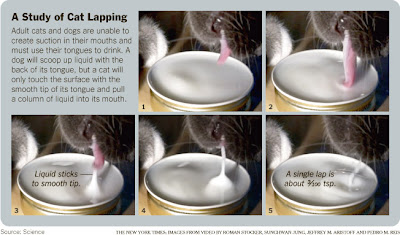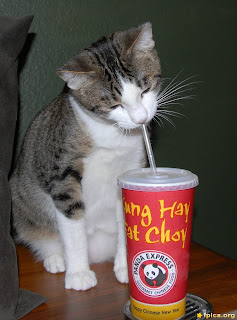Pet Projects
Here at the Virtuosi, we have a very specific way of asking a very
specific type of question that sounds anything but specific. These are
the "How come [blank]?" questions [1]. These are very simple questions
that just about every four year old asks, but likely never get
sufficiently answered. To get a feel for what I mean by these questions
I provide the following translations of problems we have either
considered or will consider:
Q: How come trees?
Translation: How tall can trees be?
Q: How come plants?
Translation: Why are plants green?
These are my very favorite types of questions because they are
completely understandable by everyone and promise to have very
interesting physics working behind the scenes. So I've been thrilled to
see two such questions considered by scientists lately that have also
had a good run in popular media. They are:
Q: How come cats?
Translation: How do cats drink? and
Q: How come dogs?
Translation: How do dogs shake?
The question of how cats drink was
answered
recently by a few dudes from MIT, Virginia Tech and Princeton. One
morning, one of the guys was just watching his cat drink water and
realized he couldn't immediately figure out how it worked, so he decided
to do a bit more research and BAM! science happens.
It turns out that the cat isn't just scooping up the water with it
tongue as one would probably have expected. Instead the cat uses its
tongue to effectively punch the water, drawing up a column of fluid.
They then bite this column and get a very itty bitty kitty mouthful of
water. Here it is in a slow motion video I stole from the Washington
Post who stole it from Reuters: (You'll probably have to sit through an
ad, apologies)
And here's a series of stills that illustrates the same thing:
 Not a cat person? Well there was also a study done a month or so ago
about dog shaking. If you have a dog, you have almost certainly
experienced the elegant way in which a wet dog un-wettafies itself.
Well, a few students at Georgia Tech were also familiar with this
shaking and just happened to have a super high speed camera that could
track water droplets. I assume it only took a short period of time to
put two and two together and BAM! science happens. In addition to
providing the logical extension of the "spherical cow" joke to "dog of
radius R", the study also found some fairly surprising results. If we
are spinning a wet cylinder (i.e. dog), we would assume that the water
is held on by some "sticking force." Then to shake off these droplets,
we'd assume that the dog would have to shake fast enough that the
centrifugal force would overcome the sticking force. In other equations,
$$ F_{centrifugal} = m{\omega}^2 R $$ and $$ F_{sticking} = C $$ So
we would then expect the shaking frequency to be the frequency that gets
those two guys to equal each other. We would thus predict
$${\omega} \sim R^{-0.5} $$
where the little squiggle just means that the frequency scales as the
radius to the -0.5 power, with some constant multipliers out front that
we don't know so we just ignore.
But this is not what the Ga Tech guys observed! Check out the video
below:
So there's still something else going on that wasn't in our simple
model. But this is what makes science so exciting! Even something dogs
and cats figured out long ago can have some really rich and interesting
physics. So keep on asking those questions! Notes: [1] Interestingly
enough, the first "How come [blank]?" questions we asked did not have
the now canonical form. Instead, it was stated as "Why are cows?". After
much deliberation, we found that the solution is "Because milkshakes."
Fair enough.
Not a cat person? Well there was also a study done a month or so ago
about dog shaking. If you have a dog, you have almost certainly
experienced the elegant way in which a wet dog un-wettafies itself.
Well, a few students at Georgia Tech were also familiar with this
shaking and just happened to have a super high speed camera that could
track water droplets. I assume it only took a short period of time to
put two and two together and BAM! science happens. In addition to
providing the logical extension of the "spherical cow" joke to "dog of
radius R", the study also found some fairly surprising results. If we
are spinning a wet cylinder (i.e. dog), we would assume that the water
is held on by some "sticking force." Then to shake off these droplets,
we'd assume that the dog would have to shake fast enough that the
centrifugal force would overcome the sticking force. In other equations,
$$ F_{centrifugal} = m{\omega}^2 R $$ and $$ F_{sticking} = C $$ So
we would then expect the shaking frequency to be the frequency that gets
those two guys to equal each other. We would thus predict
$${\omega} \sim R^{-0.5} $$
where the little squiggle just means that the frequency scales as the
radius to the -0.5 power, with some constant multipliers out front that
we don't know so we just ignore.
But this is not what the Ga Tech guys observed! Check out the video
below:
So there's still something else going on that wasn't in our simple
model. But this is what makes science so exciting! Even something dogs
and cats figured out long ago can have some really rich and interesting
physics. So keep on asking those questions! Notes: [1] Interestingly
enough, the first "How come [blank]?" questions we asked did not have
the now canonical form. Instead, it was stated as "Why are cows?". After
much deliberation, we found that the solution is "Because milkshakes."
Fair enough.

Comments
Comments powered by Disqus